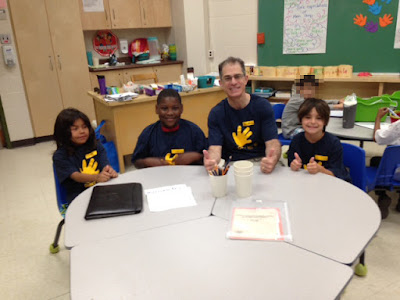Book Review: Sparking Student Creativity
by Patti Drapeau
Concerned that
creativity is lacking in many
classrooms, Patti Drapeau offers Sparking Student Creativity as a practical
resource guide for teachers to promote its use.
She begins by
outlining her Creativity Road Map, which
is a useful framework for teachers wishing to spark creativity in their
students. Its foundation is a safe classroom environment in which “The
teacher supports creativity by encouraging unusual ideas and provides positive
feedback”. (15) The framework consists of 4 parts:- Use of verbs and phrases that spark creative thinking(
ie. brainstorm, predict, create,
improve);
- Focus on creative teaching strategies such as brainstorming, visualizing, and symbolizing;
- Use of the step-by-step problem solving process; and,
- Development of a variety of responses and products (ie. written, oral, visual, kinesthetic).
Chapter 2 also
outlines Paul Torrance’s four creative thinking skills:
- Fluency
– The ability to
generate many ideas;
- Flexibility
- The ability to
generate different kinds of ideas;
- Originality
– The ability to generate
unusual, one-of-a-kind ideas;
- Elaboration – The ability to extend ideas.
Fluency can be promoted through brainstorming. A strategy for developing flexibility in students is categorization. Elaboration
can be introduced by “encouraging students to piggyback on each other’s
ideas”. (24) As well, real-world
examples of elaboration can be used, such as building additions, movie sequels,
and scientific theories.
 |
| Torrance’s four creative thinking skills |
A great
feature of this book is that many Grab and Go
teaching strategies for developing student creativity are provided. For instance, a Starter Phrase such as “New ways to do something” will spark fluency, while originality can be targeted with Starter Phrases like “Invent a …” and “Devise your own way to …”.
(28-29) Reverse Brainstorming is a strategy that promotes fluency and flexibility. Students are instructed to come up with as many ideas
as they can about the opposite of what they want. For example, “Increase pollution instead of
reducing pollution.” (31) My favourite Grab and Go idea from Chapter 2 is Lost & Found, whereby students
pretend to discover lost information, such as a missing chapter from a novel
they are studying, that provides elaboration.
Four
conditions that allow imagination to flourish are identified in Chapter 4:
In Chapter 3,
the author looks at the intersection between learning goals and
creativity. A “back door” way she
recommends of using creativity to aid students in meeting standards is to alter
the standard by either replacing the verb with a creative thinking verb or
modifying or adding adjectives and adverbs that describe the degree to which
the student is required to respond.
 |
| Thinking Verbs |
- Provide challenges – especially real-world ones;
- Provide foundational knowledge;
- Create a safe risk taking environment; and,
- Provide motivation by attaching value to learning opportunities, giving the right level of challenge, and ensuring students have the necessary learning tools.
Chapter 5
outlines strategies for encouraging innovation.
First, students need to be made aware of the steps in the innovation
process – brainstorm, evaluate ideas and needs, identify enablers and
disablers, and reflect. Students should also
be given a physical space to innovate – a think tank area. (97) Another strategy is for the teacher to
provide real examples of how someone took an idea and turned it into an
innovation.
Chapter 6 explores strategies for helping
students be successful in creative problem solving. To be effective in problem
solving, students must be encouraged to suspend judgement and must be able to
detect bias. The classroom environment
should expose them to the steps in the problem solving process and have visual
displays of these steps.  |
| Heinz History Center Innovation Station |
Nervous Nellie is an interesting Grab and Go strategy for promoting innovation. Students brainstorm several different worries
about a situation and then come up with a variety of ways to alleviate these
worries. Creating Consensus involves folding a sheet of paper into 8 squares
and having a student draw a picture of his/her innovation in the first square. In the second square, after discussion and
questions from other students, the student writes the first step that is needed
to enable the innovation. Then, in turn,
other students add what each of them thinks should be the next steps to
complete the innovation process.
The first step
in the problem solving process is for students “to list what they do not know,
what they think they know, and what they definitely know about the problem.”
(123) Then they research all aspects of
the problem to determine what is the “overarching problem” (125) Next, students
brainstorm as many solutions as possible to the problem. They then establish
criteria for determining the best of these solutions. After pausing for reflection, students determine
the resources, methods, and skills required for successful implementation of
the solution and consider the context.
In Chapter 7,
a few suggestions regarding creativity and assessment are given. Students should be explicitly made aware of
learning goals and success criteria related to creativity. As well, the shared vocabulary around
creativity should be used in the rubrics.
Lastly, when a teacher assesses student work, he/she needs to
distinguish between mistakes – trivial
slip ups that the student can easily fix – and errors – more serious wrong answers or misapplications that reflect
a lack of knowledge and require remediation. 











